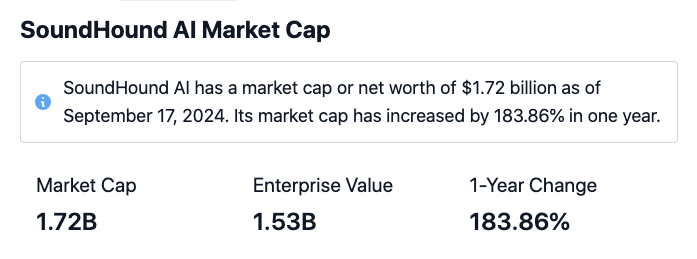20 Handy Ideas For Deciding On Stocks Ai Sites
20 Handy Ideas For Deciding On Stocks Ai Sites
Blog Article
Top 10 Tips For Evaluating Market Coverage Using Ai Stock Predicting/Analyzing Trading Platforms
Market coverage is among the most important aspects to consider when evaluating AI-based trading platforms. This determines how many markets and assets are accessible. Platforms with extensive market coverage allow you to diversify your options and discover global opportunities as well as adapt to a variety of trading strategies. Here are the top 10 suggestions to evaluate the market coverage offered by these platforms:
1. Evaluate Supported Asset Classes
Stocks: Ensure that the platform includes stocks from all major stock exchanges, such as NYSE, NASDAQ and LSE.
ETFs - See whether your platform can support an extensive selection of ETFs which offer exposure to a variety of diverse regions, sectors or themes.
Options and futures. Find out if your platform offers derivatives including options, futures or other leveraged instrument.
Forex and commodities: See whether your platform has commodities and forex, precious metals and energy commodities.
Cryptocurrencies: Make sure the platform is compatible with major copyright (e.g., Bitcoin, Ethereum) and altcoins.
2. Check for Coverage Area
Global markets - Make sure that the platform has the capacity to cover every major market around the world, including North America (including copyright), Europe, Asia-Pacific markets and emerging ones.
Regional focus: Find out if your platform has a specific focus on a region or market that aligns to your trading needs.
Local exchanges - Examine to see if there are local or regional exchanges available which are relevant to your area and strategy.
3. Assessment Real-time as opposed to. Delayed Data
Real-time data: Ensure the platform provides real-time market data for timely decision-making, especially for trading that is active.
Delayed data - Check whether delayed data is free or is available at a lower cost. This could be enough to investors who want to invest over the long-term.
Data latency: See if the platform minimizes latency for data, particularly in high-frequency trading.
4. Review the availability of historical data
In depth and breadth of data from the past: Make sure that the platform has extensive historical data (e.g. for at least 10 years) for backtesting.
Granularity: Check if historical data includes intraday, daily weekly, monthly and intraday granularity.
Corporate actions: Examine to determine if the data has been reported prior to. Dividends or stock splits all other corporate actions need to be included.
5. Check for market depth and order information
Data Level 2: Make sure that the platform provides Level 2 (order book depth), for better price discovery.
Check the bid-ask ranges to confirm the accuracy of pricing.
Volume data: Find out if your platform provides specific volume data for analyzing market activity and liquidity.
6. Examine the coverage of Indices and Sectors
Major indices: Ensure that your platform is compatible with major indices, such as the S&P 500 (e.g. NASDAQ 100 or FTSE 100), for index-based benchmarking.
Data from specific sectors for targeted analysis, you should check whether the platform includes data from specific industries (e.g. health care, technology).
Custom indices. Make sure the platform can track or create custom indices that satisfy your requirements.
7. Test the Integration of News and Sentiment Data
News feeds - Make sure your platform has the most up-to-date, market-moving news feeds (e.g. Bloomberg, Reuters).
Check the platform's sentiment analysis tool using information from social media, news or other sources.
Event-driven Strategies: Check if the platform supports strategies that are triggered by certain events (e.g. economic reports, earnings announcements).
8. Check for Multi-Market Capabilities for Trading
Cross-market trading: Make sure the platform supports trading across a variety of markets and asset classes through one interface.
Conversion of currencies Check to see whether you can convert currencies in a way that is automatic for international transactions and if there are multi-currency account options.
Support for time zones: Find out if your platform allows you to trade in different time zones.
9. Check out alternative data sources
Alternative data: To gain new insights, make sure that the platform is able to incorporate different data sources.
ESG data - Check that the platform provides environmental, governance, and social information (ESG). This is crucial for the socially conscious investment.
Macroeconomic data: Ensure the platform provides macroeconomic indicators (e.g., inflation, GDP, interest rates) to conduct a fundamental analysis.
Examine the Feedback of Users and Review the Market Reputation
Feedback from users is an excellent method to assess the market the platform's coverage.
The reputation of the market: Find out if there are any prizes or experts who acknowledge the platform for its coverage of the market.
Case studies: Look for reviews or case studies that demonstrate the platform's effectiveness in specific assets or markets.
Bonus Tips
Trial period for free: Try the coverage in the marketplace of the platform and the quality of its data with the demo or trial for free.
API access: Make sure the API is available on the platform that permits you to programmatically access market data for a custom analysis.
Customer Support: Make sure that the platform is able to offer support for any data-related or market-related issues.
Use these guidelines to assess the market coverage offered by AI stock trading platforms. Choose a platform with access to the markets, data and tools that you need to make trading successful. Market coverage that is comprehensive allows you to diversify your portfolio, look for new opportunities, and adapt to the changing market conditions. Take a look at the most popular ai for investing hints for site advice including ai trading, ai based trading platform, ai investment app, free ai trading bot, chart analysis ai, trader ai review, stock analysis websites, trading ai, free ai tool for stock market india, copyright financial advisor and more.
Top 10 Tips On Assessing Regulatory Compliance With Ai Stock Predicting/Analyzing Trading Platforms
The regulatory compliance aspect plays an important part in the evaluation of AI platforms for stock prediction and analysis. Compliance ensures a platform's operation within legal frameworks. Users data is protected and financial regulations are complied with, which reduces any risk of legal problems. Here are 10 tips to assess the compliance of these platforms.
1. Verify the validity of your license and registration.
Regulatory Authorities: Ensure that the platform registered with the appropriate regulatory authorities (e.g. SEC US, FCA UK and ASIC Australia) and holds an authorization.
Broker partnerships: Make sure that brokers that are a part of the platform are licensed.
Public records: Go to the website of the regulator to find the status of registration for the platform and any previous violations.
2. Verify Data Privacy Compliance
GDPR - If your site operates within the EU or serves users from the EU ensure that it is compliant with GDPR.
CCPA For those who reside who reside in California Verify conformity to the California Consumer Privacy Act (CCPA).
Policy on handling data: Ensure you read the privacy policies to learn the ways in which data of users is stored and collected.
3. Examining anti-money laundering measures
AML Policies The platform must have solid AML (Anti-Money Laundering) policies that detect money laundering and prevent it.
KYC procedures - Verify that the platform adheres to Know Your Customer procedures for verification of user identities.
Transaction monitoring: Verify that the platform monitors transactions in order to identify suspicious activity and inform authorities about suspicious activity.
4. Verify conformity with Trading Regulations
Market manipulation: Ensure that your platform has measures to stop market manipulations, like swap trading or fake trading.
Order types. Check that the platform conforms to the regulations pertaining to order types (e.g. there is no illegal stop loss hunting).
Best execution : Make sure that the platform is using top execution techniques to complete trades at the lowest cost.
5. Cybersecurity Assessment
Data encryption: Ensure that the platform uses encryption to protect the data of users in transit and in rest.
Incident response: Verify that the platform has an incident response plan in place for cyber-attacks and data breaches.
Certifications - Check to see whether your platform is certified. cybersecurity certifications.
6. Examine Transparency and Transparency
Fee disclosure: Ensure that the platform is clear about the total amount of fees, which includes hidden or additional charges.
Risk disclosure: Make sure there is a clear declaration of the risk, especially in high-risk or leveraged trading strategies.
Performance reporting: Find out whether the AI platform's models are transparently and correctly and accurately reported.
7. Make sure that the product is in compliance with International Regulations
Transborder trade If you are planning to trade internationally make sure the platform complies with all applicable laws.
Tax reporting - Find out the platform's tools and reports to aid users in complying with tax regulations.
Check for compliance with sanctions. Verify that the platform is in compliance with sanctions to the sanctions and will not allow dealings or transactions with banned entities or countries.
8. Assessing Record-Keeping and Audit trails
Records of transactions: The platform should maintain detailed records on the transactions that are used for regulatory and auditor reasons.
Logs of user activity: Check whether the platform records the user's activity, such as logins, trades, and changes to account settings.
Audit readiness: Verify that the platform can provide all documentation and logs if an audit by a regulatory agency occurs.
9. Make sure you are in compliance with AI-specific Regulations
Algorithmic rules for trading If the platform for trading uses algorithms, ensure that it complies to the regulations of MiFID II for Europe or Reg. SCI for the U.S.
Fairness and bias: Determine whether the platform modifies or checks its AI models for ethical and fair trading.
Explainability: As stipulated by specific regulations, the system should be able to provide clear explanations for AI-driven predictions and decisions.
Review User Feedback and Regulatory History
User feedback: Read user reviews to gauge the reputation of the platform for regulatory conformity.
Check the regulatory history to see if there are penalties or fines for violations of rules.
Third-party Audits: Verify that the platform is subject to third-party reviews to ensure the platform is conforming to all laws and regulations.
Bonus Tips:
Legal consultation: Talk to an attorney to make sure that the platform complies with the relevant laws.
Trial period: Test the platform for free or utilize the demo feature to test its compliance features and the documentation.
Customer Support: Make sure that the platform has assistance to customers with any questions or issues related to compliance.
Use these guidelines to assess the regulatory compliance and protection of your interests. Compliance not only reduces legal risks but also builds confidence and trust in the service of the platform. Follow the recommended canadian ai stocks blog for website recommendations including ai investment advisor, stock analysis websites, trader ai app, best stock advisor, ai trading tools, ai trading, best stock analysis app, stock market software, ai trading platform, trader ai review and more.